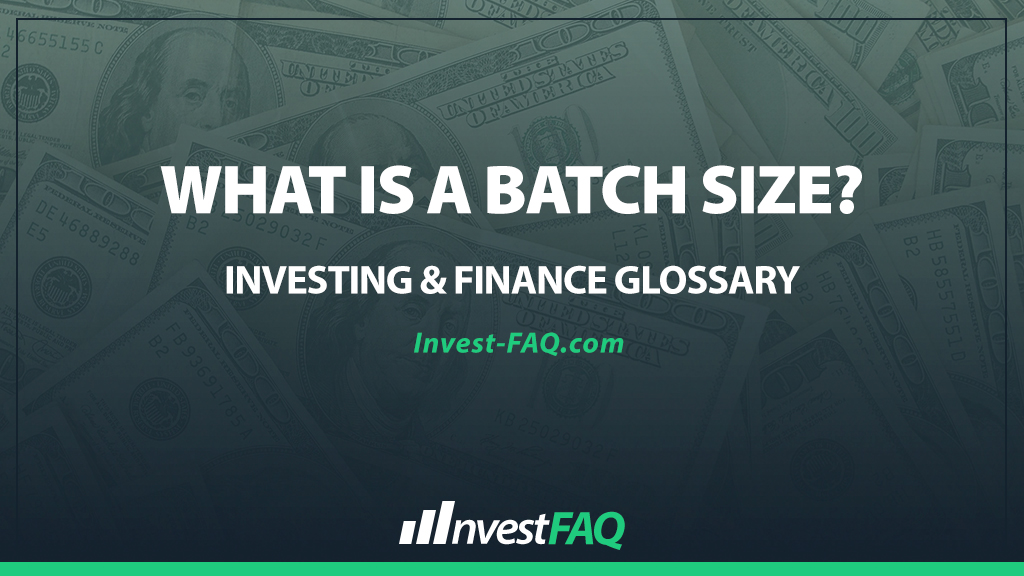
Batch Size
Contents
A batch size refers to the total number of units produced in a single production run or cycle. It represents a key operational decision in manufacturing and production processes, balancing between the efficiency of large-scale production and the flexibility and responsiveness of producing smaller quantities.
Determining the optimal batch size is crucial for businesses aiming to minimize production costs while meeting market demand efficiently.
An appropriately sized batch can help reduce setup costs per unit, manage inventory levels effectively, and respond quickly to customer orders.
In various industries, from automotive manufacturing to food production, batch size decisions impact production planning, inventory management, and overall operational strategy.
Example of a Batch Size
Imagine “Gourmet Bakery,” which specializes in artisan bread. The bakery faces a decision on the batch size for its popular sourdough bread.
If it chooses a large batch size of 200 loaves, it incurs a setup cost of $100 and direct costs (materials and labor) of $5 per loaf.
Alternatively, for a smaller batch size of 100 loaves, the setup cost remains $100, but the direct costs are the same at $5 per loaf.
Large Batch:
- Setup Cost per Loaf: $100 / 200 = $0.50 per loaf
- Direct Cost per Loaf: $5
- Total Cost per Loaf: $5.50
Small Batch:
- Setup Cost per Loaf: $100 / 100 = $1 per loaf
- Direct Cost per Loaf: $5
- Total Cost per Loaf: $6
In this scenario, producing a larger batch size reduces the setup cost per unit, illustrating the economies of scale.
However, it may also result in higher inventory levels, potentially increasing holding costs or risking product obsolescence. Conversely, smaller batches are more expensive per unit due to higher setup cost allocation but offer greater flexibility and lower inventory levels.
“Gourmet Bakery” must weigh these considerations, aligning batch size decisions with demand forecasts, production capacity, and financial objectives.
Significance for Investing & Finance
Understanding and managing batch sizes is significant in accounting and financial management for several reasons:
Cost Control: Optimizing batch sizes helps control production costs, directly influencing profitability.
Inventory Management: Batch size decisions affect inventory levels and turnover rates, impacting cash flow and storage costs.
Pricing Strategy: Accurate costing based on batch sizes aids in developing effective pricing strategies that ensure cost recovery and profit margins.
Strategic Planning: Aligning batch sizes with market demand and production capacity supports strategic planning and operational efficiency, enhancing competitive advantage.
In summary, batch size is a critical factor in production and manufacturing that affects costs, efficiency, and inventory management.
Businesses must carefully consider their batch size decisions to optimize production processes, control costs, and meet market demand effectively, thereby supporting their overall strategic and financial goals.
FAQ
How does increasing batch size impact production costs?
Increasing batch size typically reduces the setup cost per unit by spreading fixed setup costs over more units, potentially lowering the overall cost per unit, but it may increase inventory holding costs.
What factors should a company consider when determining its optimal batch size?
A company should consider factors such as demand forecasts, production capacity, setup costs, inventory holding costs, and the risk of obsolescence to determine its optimal batch size that balances cost efficiency with market responsiveness.
Can a change in batch size affect a company’s supply chain management?
Yes, changing batch sizes can significantly impact supply chain management by altering inventory levels, affecting lead times, and potentially requiring adjustments in storage and logistics strategies to accommodate different production volumes.
How do businesses calculate the economic batch size for a product?
Businesses calculate the economic batch size for a product using formulas like the Economic Order Quantity (EOQ) model, which considers setup costs, demand rate, and holding costs to determine the batch size that minimizes total production and inventory costs.
